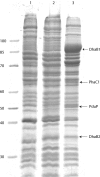Conversion of glycerol to poly(3-hydroxypropionate) in recombinant Escherichia coli
- PMID: 19933347
- PMCID: PMC2805219
- DOI: 10.1128/AEM.02097-09
Conversion of glycerol to poly(3-hydroxypropionate) in recombinant Escherichia coli
Abstract
We have developed the conversion of glycerol into thermoplastic poly(3-hydroxypropionate) [poly(3HP)]. For this, the genes for glycerol dehydratase (dhaB1) of Clostridium butyricum, propionaldehyde dehydrogenase (pduP) of Salmonella enterica serovar Typhimurium LT2, and polyhydroxyalkanoate (PHA) synthase (phaC1) of Ralstonia eutropha were expressed in recombinant Escherichia coli. Poly(3HP) was accumulated up to 11.98% (wt/wt [cell dry weight]) in a two-step, fed-batch fermentation. The present study shows an interesting application to engineer a poly(3HP) synthesis pathway in bacteria.
Figures




References
-
- Baba, H., N. Tanahashi, Y. Kumagai, and Y. Doi. 1992. Effects of molecular-structure on enzymatic degradation of polyesters. J. Chem. Soc. Jpn. 5:527-533.
-
- Bobik, T. A., G. D. Havemann, R. J. Busch, D. S. Williams, and H. C. Aldrich. 1999. The propanediol utilization (pdu) operon of Salmonella enterica serovar Typhimurium LT2 includes genes necessary for formation of polyhedral organelles involved in coenzyme B(12)-dependent 1,2-propanediol degradation. J. Bacteriol. 181:5967-5975. - PMC - PubMed
Publication types
MeSH terms
Substances
LinkOut - more resources
Full Text Sources
Other Literature Sources

